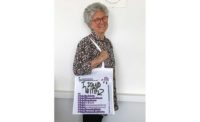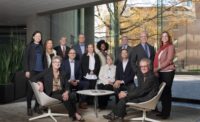At AIA 2018 Business Meeting, Resolution to Amend Code of Ethics Passes

Frances Halsband, FAIA, (left) introduced a resolution to update the AIA’s Code of Ethics and Professional Conduct, which was passed by near-unanimous vote at the 2018 Business Meeting (right).
Photos courtesy Kliment Halsband Architects (left), © Frances Halsband (right)
Voting at Wednesday night’s Annual Business Meeting of the AIA stretched more than an hour past the scheduled close as delegates heard a variety of proposals, including several focused on equity.
Among the resolutions from the floor was a proposal (Resolution 18-16), put forth by Frances Halsband, FAIA, to update the Code of Ethics and Professional Conduct, that has been gaining support throughout the industry this past month. The resolution had surpassed the needed 50 signatures to be heard from the floor by more than ten times over. And it passed with an overwhelming majority—4,272 votes in favor compared to 13 votes against (with 136 abstentions.) Given the way the votes are split between the delegates, Halsband estimates that it could have been as few as one person who voted against the move. Maybe they pushed the wrong button, she jokes.
“I was completely blown away,” Halsband says of the result, which now puts the onus on the Board of Directors to update the Code of Ethics as soon as possible. “I think I think the one message is that clearly everybody in the room understood that it absolutely was past time for the AIA to come out and make a statement on harassment—where had they been?”
Halsband was named a delegate to the meeting by AIANY after spreading a petition to other Fellows that grew into the resolution. She showed up to the meeting with some 500 paper copies of the resolution, which calls for amending the Code of Ethics to include clearer rules about discrimination, harassment, and abuse, including consequences for harassers. When the time came, she read the resolution to the “vast room full of people with lots of opinions,” and was overwhelmed by the support.
“That was completely amazing, because people started standing up from representing chapters from all over the country and saying, ‘You've got to do this. This is the time you've got to pass this thing,’ ” she says.
The response to the resolution mirrors the feedback Halsband has received while emailing industry members, she says. As with the Business Meeting vote, her email outreach was not met with criticism by fellow architects, though some did not respond. “But I don't know if that was a spam filter or their belief system,” Halsband says, “or both.”
Though the “yes” vote puts pressure on the Board to move forward, Halsband notes that there’s still more to be done. “We’re saying to the Board that they need to act on this as fast as possible,” Halsband says. “The Board is constitutionally able to do this. They don't need any other help from anybody; they could walk into a room tomorrow and vote on it. The next official board meeting is in September. We need to keep up the pressure to make sure that they are fully ready to act in September.”


